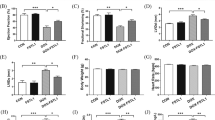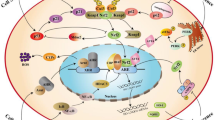Abstract
Sestrins are evolutionary conserved stress-inducible genes which regulate the axis of cell survival and cell death. Suppression of Sestrin 2 (SESN2) has been linked with increase in oxidative stress and cell death but mechanistic details related to regulation of SESN2 during mitochondrial damage remain unknown. Our study shows that prolonged CCCP-induced mitochondrial damage decreases SESN2 levels and viability of SH-SY5Y cells while overexpression of SESN2 significantly rescues the viability of cells. Further, we demonstrate that Ring box protein 1 (RBX1) is a novel interactive partner and E3 ligase for SESN2 which mediates its K-48-linked ubiquitination upon extensive mitochondrial damage. Downregulation of RBX1 causes stabilization in levels of SESN2. Notably, silencing of RBX1 expression substantially declines cell death and generation of mitochondrial ROS in response to prolonged mitochondrial damage. Taken together, we suggest that SESN2 is critical to protect cells against detrimental effect of mitochondrial damage and RBX1 is a negative regulator of SESN2 which hampers its stabilization.





Similar content being viewed by others
Abbreviations
- SESN2:
-
Sestrin2
- CCCP:
-
Carbonyl cyanide m-chlorophenylhydrazone
- RBX1:
-
Ring box protein 1
- AMPK:
-
AMP kinase
- AD:
-
Alzheimer’s disease
- PD:
-
Parkinson’s disease
References
Kourtis N, Tavernarakis N (2011) Cellular stress response pathways and ageing: intricate molecular relationships. The EMBO J 30(13):2520–2531. https://doi.org/10.1038/emboj.2011.162
Cheng Z, Ristow M (2013) Mitochondria and metabolic homeostasis. Antioxid Redox Signal 19(3):240–242. https://doi.org/10.1089/ars.2013.5255
Murphy E, Steenbergen C (2007) Preconditioning: the mitochondrial connection. Annu Rev Physiol 69:51–67. https://doi.org/10.1146/annurev.physiol.69.031905.163645
Qureshi MA, Haynes CM, Pellegrino MW (2017) The mitochondrial unfolded protein response: signaling from the powerhouse. J Biol Chem 292(33):13500–13506. https://doi.org/10.1074/jbc.R117.791061
Zhao Q, Wang J, Levichkin IV, Stasinopoulos S, Ryan MT, Hoogenraad NJ (2002) A mitochondrial specific stress response in mammalian cells. EMBO J 21(17):4411–4419
Mehler MF (2017) Shining a light on early stress responses and late-onset disease vulnerability. Proc Natl Acad Sci USA 114(9):2109–2111. https://doi.org/10.1073/pnas.1700323114
Tait SW, Green DR (2013) Mitochondrial regulation of cell death. Cold Spring Harbor Perspect Biol. https://doi.org/10.1101/cshperspect.a008706
Lim ML, Minamikawa T, Nagley P (2001) The protonophore CCCP induces mitochondrial permeability transition without cytochrome c release in human osteosarcoma cells. FEBS Lett 503(1):69–74
Carroll RG, Hollville E, Martin SJ (2014) Parkin sensitizes toward apoptosis induced by mitochondrial depolarization through promoting degradation of Mcl-1. Cell Rep 9(4):1538–1553. https://doi.org/10.1016/j.celrep.2014.10.046
Maiuri MC, Zalckvar E, Kimchi A, Kroemer G (2007) Self-eating and self-killing: crosstalk between autophagy and apoptosis. Nat Rev Mol Cell Biol 8(9):741–752. https://doi.org/10.1038/nrm2239
Winklhofer KF, Haass C (2010) Mitochondrial dysfunction in Parkinson’s disease. Biochim Biophys Acta 1802(1):29–44. https://doi.org/10.1016/j.bbadis.2009.08.013
Osellame LD, Duchen MR (2013) Defective quality control mechanisms and accumulation of damaged mitochondria link Gaucher and Parkinson diseases. Autophagy 9(10):1633–1635. https://doi.org/10.4161/auto.25878
Moreira PI, Carvalho C, Zhu X, Smith MA, Perry G (2010) Mitochondrial dysfunction is a trigger of Alzheimer’s disease pathophysiology. Biochim Biophys Acta 1802(1):2–10. https://doi.org/10.1016/j.bbadis.2009.10.006
Lee JH, Budanov AV, Karin M (2013) Sestrins orchestrate cellular metabolism to attenuate aging. Cell Metab 18(6):792–801. https://doi.org/10.1016/j.cmet.2013.08.018
Budanov AV, Lee JH, Karin M (2010) Stressin’ Sestrins take an aging fight. EMBO Mol Med 2(10):388–400. https://doi.org/10.1002/emmm.201000097
Lee JH, Budanov AV, Park EJ, Birse R, Kim TE, Perkins GA, Ocorr K, Ellisman MH, Bodmer R, Bier E, Karin M (2010) Sestrin as a feedback inhibitor of TOR that prevents age-related pathologies. Science 327(5970):1223–1228. https://doi.org/10.1126/science.1182228
Saveljeva S, Cleary P, Mnich K, Ayo A, Pakos-Zebrucka K, Patterson JB, Logue SE, Samali A (2016) Endoplasmic reticulum stress-mediated induction of SESTRIN 2 potentiates cell survival. Oncotarget 7(11):12254–12266. https://doi.org/10.18632/oncotarget.7601
Byun JK, Choi YK, Kim JH, Jeong JY, Jeon HJ, Kim MK, Hwang I, Lee SY, Lee YM, Lee IK, Park KG (2017) A positive feedback loop between Sestrin2 and mTORC2 is required for the survival of glutamine-depleted lung cancer cells. Cell Rep 20(3):586–599. https://doi.org/10.1016/j.celrep.2017.06.066
Budanov AV, Karin M (2008) p53 target genes sestrin1 and sestrin2 connect genotoxic stress and mTOR signaling. Cell 134(3):451–460. https://doi.org/10.1016/j.cell.2008.06.028
Kim MG, Yang JH, Kim KM, Jang CH, Jung JY, Cho IJ, Shin SM, Ki SH (2015) Regulation of toll-like receptor-mediated Sestrin2 induction by AP-1, Nrf2, and the ubiquitin-proteasome system in macrophages. Toxicol Sci 144(2):425–435. https://doi.org/10.1093/toxsci/kfv012
Chai D, Wang G, Zhou Z, Yang H, Yu Z (2015) Insulin increases sestrin 2 content by reducing its degradation through the PI 3 K/mTOR signaling pathway. Int J Endocrinol 2015:505849. https://doi.org/10.1155/2015/505849
Bae SH, Sung SH, Oh SY, Lim JM, Lee SK, Park YN, Lee HE, Kang D, Rhee SG (2013) Sestrins activate Nrf2 by promoting p62-dependent autophagic degradation of Keap1 and prevent oxidative liver damage. Cell Metab 17(1):73–84. https://doi.org/10.1016/j.cmet.2012.12.002
Yang D, Li L, Liu H, Wu L, Luo Z, Li H, Zheng S, Gao H, Chu Y, Sun Y, Liu J, Jia L (2013) Induction of autophagy and senescence by knockdown of ROC1 E3 ubiquitin ligase to suppress the growth of liver cancer cells. Cell Death Differ 20(2):235–247. https://doi.org/10.1038/cdd.2012.113
Yang D, Zhao Y, Liu J, Sun Y, Jia L (2012) Protective autophagy induced by RBX1/ROC1 knockdown or CRL inactivation via modulating the DEPTOR-MTOR axis. Autophagy 8(12):1856–1858. https://doi.org/10.4161/auto.22024
Park HW, Park H, Ro SH, Jang I, Semple IA, Kim DN, Kim M, Nam M, Zhang D, Yin L, Lee JH (2014) Hepatoprotective role of Sestrin2 against chronic ER stress. Nat Commun 5:4233. https://doi.org/10.1038/ncomms5233
Tripathi R, Ash D, Shaha C (2014) Beclin-1-p53 interaction is crucial for cell fate determination in embryonal carcinoma cells. J Cell Mol Med 18(11):2275–2286. https://doi.org/10.1111/jcmm.12386
Aich A, Shaha C (2013) Novel role of calmodulin in regulating protein transport to mitochondria in a unicellular eukaryote. Mol Cell Biol 33(22):4579–4593. https://doi.org/10.1128/MCB.00829-13
Erpapazoglou Z, Walker O, Haguenauer-Tsapis R (2014) Versatile roles of k63-linked ubiquitin chains in trafficking. Cells 3(4):1027–1088. https://doi.org/10.3390/cells3041027
Yau R, Rape M (2016) The increasing complexity of the ubiquitin code. Nat Cell Biol 18(6):579–586. https://doi.org/10.1038/ncb3358
Shortt J, Johnstone RW (2012) Oncogenes in cell survival and cell death. Cold Spring Harbor Perspect Biol. https://doi.org/10.1101/cshperspect.a009829
Lin MT, Beal MF (2006) Mitochondrial dysfunction and oxidative stress in neurodegenerative diseases. Nature 443(7113):787–795. https://doi.org/10.1038/nature05292
Zhou D, Zhan C, Zhong Q, Li S (2013) Upregulation of sestrin-2 expression via P53 protects against 1-methyl-4-phenylpyridinium (MPP+) neurotoxicity. J Mol Neurosci 51(3):967–975. https://doi.org/10.1007/s12031-013-0081-x
Murphy MP, LeVine H 3rd (2010) Alzheimer’s disease and the amyloid-beta peptide. J Alzheimer’s Dis 19(1):311–323. https://doi.org/10.3233/JAD-2010-1221
Chen YS, Chen SD, Wu CL, Huang SS, Yang DI (2014) Induction of sestrin2 as an endogenous protective mechanism against amyloid beta-peptide neurotoxicity in primary cortical culture. Exp Neurol 253:63–71. https://doi.org/10.1016/j.expneurol.2013.12.009
Seo K, Ki SH, Shin SM (2015) Sestrin2-AMPK activation protects mitochondrial function against glucose deprivation-induced cytotoxicity. Cell Signal 27(7):1533–1543. https://doi.org/10.1016/j.cellsig.2015.03.003
Ding B, Parmigiani A, Divakaruni AS, Archer K, Murphy AN, Budanov AV (2016) Sestrin2 is induced by glucose starvation via the unfolded protein response and protects cells from non-canonical necroptotic cell death. Sci Rep 6:22538. https://doi.org/10.1038/srep22538
Acknowledgements
We acknowledge technical assistance from Mr. G.S. Neelaram. This work was supported by grants from the Department of Biotechnology, New Delhi, India (http://dbtindia.nic.in/index.asp), to the National Institute of Immunology (Grant No. BT/03/033/88); Centre for Molecular Medicine, New Delhi (Grant No. BT/PR/14549/MED/14/1291).
Author information
Authors and Affiliations
Contributions
AK and CS formed the general framework of this study. AK and CS designed experiments. AK performed all experiments. AK and CS prepared the manuscript.
Corresponding author
Ethics declarations
Conflict of interest
The authors declare that they have no conflict of interest.
Electronic Supplementary Material
Below is the link to the electronic supplementary material.
Rights and permissions
About this article
Cite this article
Kumar, A., Shaha, C. RBX1-mediated ubiquitination of SESN2 promotes cell death upon prolonged mitochondrial damage in SH-SY5Y neuroblastoma cells. Mol Cell Biochem 446, 1–9 (2018). https://doi.org/10.1007/s11010-017-3267-7
Received:
Accepted:
Published:
Issue Date:
DOI: https://doi.org/10.1007/s11010-017-3267-7




